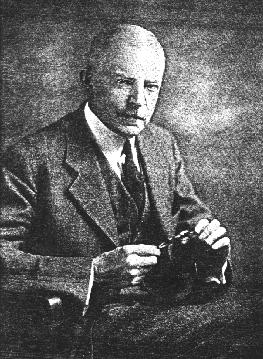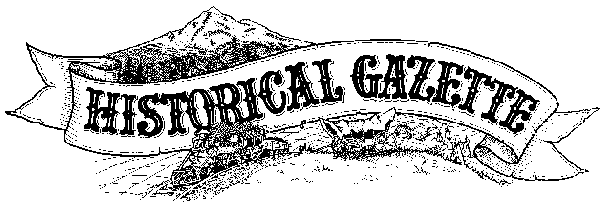August to December 1900
Excerpted from USGS Reports
The Gold Belt of the Blue Mountains
of Oregon
by Waldemar Lindgren
Canyon District
--Placer Deposits--

The placers of Canyon are justly celebrated as the most important and productive deposits of the kind in Oregon. They were discovered in 1862, and in less than a year many thousand miners were at work on the gravel bars of the creek and in the gulches of the surrounding hills. During the first few years the production was very great, but exact figures will probably never be known. Estimatess are made varying from $3,000,000 to $5,000,000 a year. In 1865 the product was estimated at $22,000 a week {Raymond's report, 1870}, or about $1,000,000 a year. In 1870 it had already fallen to $300,000 a year. In the following year the production was still further reduced, but remained for a long time about $100,000. The Mint reports for 1883 and 1884 estimate $87,000 and $80,000; for 1890 $72,000, and for 1891 $100,000. While the figures are incomplete and untrustworthy, it is scarcly probable that the total production must exeed $15,000,000. In 1882 there were 16 hydraulic plants {many of them small} in operation, and two-thirds of the products were derived from Chinese companies.
At the present time both white and Chinese miners are operating, mostly on a small scale. Mines near Marysville and the Humboldt hydraulic mine were worked. The amount annually extracted from the placers during the last few years probably varies between $30,000 and $50,000.
The water supply is abundant, being secured from Canyon Creek and gulches east of it. The principal ditches are reported as follows: Miners ditch 20 miles, 700 inches Hillis ditch 11 miles, 800 inches Thompson ditch 4 miles,600 inches Humboldt ditch 8 miles, 1200 inches Lone Srar ditch 4 miles, 500 inches Forlorn Hope ditch 4 miles, 500 inches
Resting on basalt and rhyolite tuff are heavy, coarse gravels, which are well exposed on the west side of the creek at Canyon, where they are 150 feet deep and overlain by finer gravel, in part sandy or clayey. At the Humboldt hydraulic mine 80 feet of the latter is exposed. On the south side of the creek, on the road leading up to Marysville and the Great Northern mine, much of these overlying sandy and clayey sediments are exsposed, and they reach up to the foot of the mountains at an elevation of 3,900 feet, 750 feet above the town. In the gulches descending from the gold-seamed Canyon Peak, which have cut into these soft deposits, rich placers are found. Some of these gravels are worked now near Marysville.
In the creek bed near Canyon a shaft is reported to have been sunk in 1873 to a depth of 300 feer without reaching bed rock.
It is clear that there is a great complication of deposits at Canyon, gravels of very different periods being present, and considerable time would be requierd to establish the exact relations. On the whole, it seems that shortly after the eruption of the basaltic and rhyolitic lavas flowing down from the north the stream was crowded over close to the mountains and heavy gravels accumulated in it. This must have taken place in the Pliocene epoch. The bottom of this channel has never been exposed. It is probable that the Pliocene gravels cover earlier accumulations of auriferous gravels, but that these can ever, if found, be profitably worked is extremely unlikely. The coarse gravels are very poor in gold--in fact, practically barren.
As the deposit deepened the width of the river bed increased, and several hundred feet of finer sediments were deposited on top of the coarse gravels. At the same time the detritus from the high mountains on the south began to push the river northward again, and during this gradual process the high bluffs on the north side of the river were formed.
The finer gravels are workable only at certain places. The most important locality is the Humboldt mine, 150 feet above Canyon and on the western side of Canyon Creek. Hydraulic operations have been carried on here for many years. A strip of ground half a mile long and several hundred feet wide has been washed, leaving a bank 80 feet in height. The bed rock is formed by coarse, cemented gravel; the pay is said to be concentrated in the first 4 feet overlying the bed rock. The exposed bed rock is nearly level, but is said to slope gently westward. This gravel mine has been worked for over thirty years, the output being reported as from $10,000 to $ 20,000 per season. These gravels, no doubt, represent the bed of Canyon Creek at a time when the main stream had already been pushed northward to nearly its present position. The rich gravels of Marysville, situated on the hill 1 1/2 miles east of Canyon, and the gravels of the present gulches above Marysville are comparatively recent deposits; they are derived from the rich pocket vein of Canyon Peak, and some of the deposits have been worked almost up up to the veins. Most of the gold has, however, been caught on the clays and gravels of the older river sediments, below the outcrops of the older rocks.
With the final establishment of the present drainage, Canyon Creek has been deepened to its present level. Its bed is from 200 to 600 feet wide, covered with gravels to a depth o 15 to 18 feet. These have, of coarse, been worked over, some parts more than once, but a certain amount of gold is still found concentrated on the bed rock. The workings extend for 5 miles up from John Day River. In 1900 prospecting shafts were sunk in these gravels with a view to dredging operations, and the results are said to have been satisfactory. The placer gold from Canyon is often 900 fine, and sometimes, as at the mouth of Canyon Gulch, 990, or $19.82 per ounce. The gold from the quartz veins averages 830 fine.
Above John Day there is apparently not much gold in the main river, but below this place for several miles the bars have been, and are still, worked by derricks and wheel barrows. The depth to bed rock is usually only about 18 feet. Extensive prospecting for dredging ground was recentlly undertaken 4 miles below John Day by the Pomeroy Company, of Portland. The results have been so satisfactory that a dredger will soon be erected here. The gravels are reported to average over 30 cents per cubic yard, most of the gold, of course, being found on the bed rock. Bed rock of serpentine and slate shows at intervals, according to Mr. J.H. Pomeroy, in the river below John Day, and the gold is often so coarse that it must be of local origin instead of having been washed down from Canyon Creek.
At Spanish Gulch, about 70 miles west of Canyon, on Crooked River, auriferous gravels were deposited on serpentine, and have been worked for many years. A production of $1,400 is given for 1882 in the Mint reports. In 1898 $16,000 was taken out in a couple of months, the gold being very coarse. This locality, which was not visited, is, as far as known, the most westerly point of the gold belt of eastern Oregon.
Another district not visited is that of Fox, Hamilton, and Long creeks, about 20 miles due west of Susanville. Small but persistent amounts of from $1,000 to $7,000 of placer gold are yearly reported from this vicinity.
These stories are available to our electronic readers as part of our contribution to the information available on the Internet. We're interested in hearing from you especially if you've been to Eastern Oregon, the Wallowas, the Blues, or if you know of Prof. Lindgren and his trips to the many other gold camps in the West. These stories are available to our electronic readers as part of our contribution to the information available on the Internet. We hope you enjoy the stories and if you have questions or comments please send a message to editor, Keith Whittle
More on Waldemar Lindgren:
[Editor's Introduction | "Gold Belt of Eastern Oregon"]Read our other gold mining editions:
[Sumpter, Oregon 1900 | Gold Seekers Rush to California]
[ Oregon: Land of Gold & Opportunity | Dequille Reports from the Comstock]

Bridget E. Smith, editor & publisher
Email | Home Page | Historic Headlines
Historical Gazette
Published in Portland, Oregon
© 1991-

